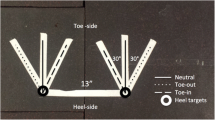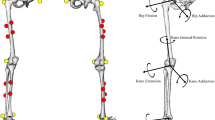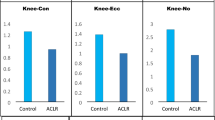Abstract
Purpose
To examine the effects of different sagittal plane body positions during single-leg landings on biomechanics and muscle activation parameters associated with risk for anterior cruciate ligament (ACL) injury.
Methods
Twenty participants performed single-leg drop landings onto a force plate using the following landing styles: self-selected, leaning forward (LFL) and upright (URL). Lower extremity and trunk 3D biomechanics and lower extremity muscle activities were recorded using motion analysis and surface electromyography, respectively. Differences in landing styles were examined using 2-way Repeated-measures ANOVAs (sex × landing conditions) followed by Bonferroni pairwise comparisons.
Results
Participants demonstrated greater peak vertical ground reaction force, greater peak knee extensor moment, lesser plantar flexion, lesser or no hip extensor moments, and lesser medial and lateral gastrocnemius and lateral quadriceps muscle activations during URL than during LFL. These modifications of lower extremity biomechanics across landing conditions were similar between men and women.
Conclusions
Leaning forward while landing appears to protect the ACL by increasing the shock absorption capacity and knee flexion angles and decreasing anterior shear force due to the knee joint compression force and quadriceps muscle activation. Conversely, landing upright appears to be ACL harmful by increasing the post-impact force of landing and quadriceps muscle activity while decreasing knee flexion angles, all of which lead to a greater tibial anterior shear force and ACL loading. ACL injury prevention programmes should include exercise regimens to improve sagittal plane body position control during landing motions.

Similar content being viewed by others
References
Arms SW, Pope MH, Johnson RJ, Fischer RA, Arvidsson I, Eriksson E (1984) The biomechanics of anterior cruciate ligament rehabilitation and reconstruction. Am J Sports Med 12(1):8–18
Baratta R, Solomonow M, Zhou BH, Letson D, Chuinard R, D’Ambrosia R (1988) Muscular coactivation. The role of the antagonist musculature in maintaining knee stability. Am J Sports Med 16(2):113–122
Blackburn JT, Padua DA (2008) Influence of trunk flexion on hip and knee joint kinematics during a controlled drop landing. Clin Biomech (Bristol Avon) 23(3):313–319
Blackburn JT, Padua DA (2009) Sagittal-plane trunk position, landing forces, and quadriceps electromyographic activity. J Athl Train 44(2):174–179
Boden BP, Dean GS, Feagin JA Jr, Garrett WE Jr (2000) Mechanisms of anterior cruciate ligament injury. Orthopedics 23(6):573–578
Boden BP, Torg JS, Knowles SB, Hewett TE (2009) Video analysis of anterior cruciate ligament injury: abnormalities in hip and ankle kinematics. Am J Sports Med 37(2):252–259
Cerulli G, Benoit DL, Lamontagne M, Caraffa A, Liti A (2003) In vivo anterior cruciate ligament strain behaviour during a rapid deceleration movement: case report. Knee Surg Sports Traumatol Arthrosc 11(5):307–311
Chappell JD, Herman DC, Knight BS, Kirkendall DT, Garrett WE, Yu B (2005) Effect of fatigue on knee kinetics and kinematics in stop-jump tasks. Am J Sports Med 33(7):1022–1029
Cortes N, Morrison S, Van Lunen BL, Onate JA (2012) Landing technique affects knee loading and position during athletic tasks. J Sci Med Sport 15(2):175–181
Cortes N, Onate J, Abrantes J, Gagen L, Dowling E, Van Lunen B (2007) Effects of gender and foot-landing techniques on lower extremity kinematics during drop-jump landings. J Appl Biomech 23(4):289–299
DeMorat G, Weinhold P, Blackburn T, Chudik S, Garrett W (2004) Aggressive quadriceps loading can induce noncontact anterior cruciate ligament injury. Am J Sports Med 32(2):477–483
Hargrave MD, Carcia RC, Gansneder BM, Shultz SJ (2003) Subtalar pronation does not influence impact forces or rate of loading during a single-leg landing. J Athl Train 38(1):18–23
Hashemi J, Breighner R, Chandrashekar N, Hardy DM, Chaudhari AM, Shultz SJ, Slauterbeck JR, Beynnon BD (2011) Hip extension, knee flexion paradox: a new mechanism for non-contact ACL injury. J Biomech 44(4):577–585
Hewett TE, Torg JS, Boden BP (2009) Video analysis of trunk and knee motion during non-contact anterior cruciate ligament injury in female athletes: lateral trunk and knee abduction motion are combined components of the injury mechanism. Br J Sports Med 43(6):417–422
Kulas AS, Hortobagyi T, Devita P (2010) The interaction of trunk-load and trunk-position adaptations on knee anterior shear and hamstrings muscle forces during landing. J Athl Train 45(1):5–15
Laughlin WA, Weinhandl JT, Kernozek TW, Cobb SC, Keenan KG, O’Connor KM (2011) The effects of single-leg landing technique on ACL loading. J Biomech 44(10):1845–1851
Li G, Rudy TW, Sakane M, Kanamori A, Ma CB, Woo SL (1999) The importance of quadriceps and hamstring muscle loading on knee kinematics and in situ forces in the ACL. J Biomech 32(4):395–400
McLean SG, Andrish JT, van den Bogert AJ (2005) Aggressive quadriceps loading can induce noncontact anterior cruciate ligament injury. Am J Sports Med 33(7):1106; author reply 1106–1107
Meyer EG, Haut RC (2005) Excessive compression of the human tibio-femoral joint causes ACL rupture. J Biomech 38(11):2311–2316
Meyer EG, Haut RC (2008) Anterior cruciate ligament injury induced by internal tibial torsion or tibiofemoral compression. J Biomech 41(16):3377–3383
Miyasaka K, Daniel D, Stone M (1991) The incidence of knee ligament injuries in the general population. Am J Knee Surg 4:43–48
Nunley R, Wright D, Renner J, Yu B, Garrett WJ (2003) Gender comparison of patella tendon tibial shaft angle with weight bearing. Res Sports Med 11(3):173–185
Olsen OE, Myklebust G, Engebretsen L, Bahr R (2004) Injury mechanisms for anterior cruciate ligament injuries in team handball: a systematic video analysis. Am J Sports Med 32(4):1002–1012
Pflum MA, Shelburne KB, Torry MR, Decker MJ, Pandy MG (2004) Model prediction of anterior cruciate ligament force during drop-landings. Med Sci Sports Exerc 36(11):1949–1958
Rainoldi A, Melchiorri G, Caruso I (2004) A method for positioning electrodes during surface EMG recordings in lower limb muscles. J Neurosci Methods 134:37–43
Self BP, Paine D (2001) Ankle biomechanics during four landing techniques. Med Sci Sports Exerc 33(8):1338–1344
Sheehan FT, Sipprell WH 3rd, Boden BP (2012) Dynamic sagittal plane trunk control during anterior cruciate ligament injury. Am J Sports Med. doi:10.1177/0363546512437850
Shimokochi Y, Meyer E (2011) Sagittal plane body positions influence tibial anterior shear force during single-leg landing. Br J Sports Med 45(4):373
Shimokochi Y, Shultz SJ (2008) Mechanisms of noncontact anterior cruciate ligament injury. J Athl Train 43(4):396–408
Shimokochi Y, Yong Lee S, Shultz SJ, Schmitz RJ (2009) The relationships among sagittal-plane lower extremity moments: implications for landing strategy in anterior cruciate ligament injury prevention. J Athl Train 44(1):33–38
Shultz SJ, Schmitz RJ (2009) Effects of transverse and frontal plane knee laxity on hip and knee neuromechanics during drop landings. Am J Sports Med 37(9):1821–1830
Solomonow M, Baratta R, Zhou BH, Shoji H, Bose W, Beck C, D’Ambrosia R (1987) The synergistic action of the anterior cruciate ligament and thigh muscles in maintaining joint stability. Am J Sports Med 15(3):207–213
Tokuyama M, Ohashi H, Iwamoto H, Takaoka K, Okubo M (2005) Individuality and reproducibility in high-speed motion of volleyball spike jumps by phase-matching and averaging. J Biomech 38(10):2050–2057
Wall SJ, Rose DM, Sutter EG, Belkoff SM, Boden BP (2012) The role of axial compressive and quadriceps forces in noncontact anterior cruciate ligament injury: a cadaveric study. Am J Sports Med 40(3):568–573
Winter DA (2009) Biomechanics and motor control of human movement, 4th edn. Wiley, New York
Zazulak BT, Hewett TE, Reeves NP, Goldberg B, Cholewicki J (2007) Deficits in neuromuscular control of the trunk predict knee injury risk: a prospective biomechanical-epidemiologic study. Am J Sports Med 35(7):1123–1130
Zazulak BT, Hewett TE, Reeves NP, Goldberg B, Cholewicki J (2007) The effects of core proprioception on knee injury: a prospective biomechanical-epidemiological study. Am J Sports Med 35(3):368–373
Acknowledgments
These data were collected during a funded appointment supported by NIH-NIAMS Grant R01- AR53172.
Author information
Authors and Affiliations
Corresponding author
Rights and permissions
About this article
Cite this article
Shimokochi, Y., Ambegaonkar, J.P., Meyer, E.G. et al. Changing sagittal plane body position during single-leg landings influences the risk of non-contact anterior cruciate ligament injury. Knee Surg Sports Traumatol Arthrosc 21, 888–897 (2013). https://doi.org/10.1007/s00167-012-2011-9
Received:
Accepted:
Published:
Issue Date:
DOI: https://doi.org/10.1007/s00167-012-2011-9




